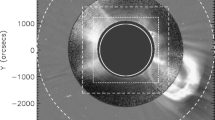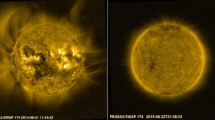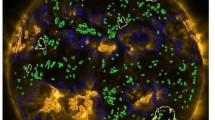Abstract
The PRoject for OnBoard Autonomy 2/Sun Watcher using Active pixel system detector and image Processing (PROBA2/SWAP) instrument images the full-disk extreme ultraviolet (EUV) Sun using a complementary metal-oxide semiconductor active-pixel sensor (CMOS-APS) detector with a filter centered on a 174 Å passband at a cadence of one to two minutes. In contrast, the Atmosphere Imaging Assembly (AIA) instrument onboard the Solar Dynamics Observatory (SDO) has a passband filter centered on 171 Å and uses a charge-coupled device (CCD) detector to make full-disk observations of the EUV corona. The images that these two telescope designs produce are visually quite similar in active regions, coronal loops, and the quiet corona. This work takes a deeper look at the stability of the most difficult coronal features to capture in an image: polar coronal holes. Polar coronal holes are the longest-lived features on the Sun and are critical to understand the global state of the solar corona, but because of an oblique viewing angle, obstruction due to the coronal plasma scale height and lack of ground-truth magnetic-field measurements make reliable segmentation of polar holes difficult. We use perimeter tracing to make consistent measurements of a polar-hole’s perimeter and area in both SWAP 174 Å and AIA 171 Å images. The generated time series of coronal-hole parameters rarely agree with each other. Direct comparison of polar-hole measurements generated by these two imagers allows us to simultaneously analyze the physical properties of polar coronal holes and to identify systematic differences between the two different instruments.




Similar content being viewed by others
Data Availability
The datasets analyzed during the current study are publicly available from the following archives: AIA images from jsoc.stanford.edu/ and SWAP Stacked images from proba2.sidc.be/swap/data/carrington rotations/. The datasets generated during the current study are available from the corresponding author on reasonable request.
References
Barnes, W.T., Cheung, M.C.M., Bobra, M.G., Boerner, P.F., Chintzoglou, G., Leonard, D., Mumford, S.J., Padmanabhan, N., Shih, A.Y., Shirman, N., Stansby, D., Wright, P.J.: 2020, aiapy: a Python package for analyzing solar EUV image data from AIA. J. Open Source Softw. 5, 2801. DOI.
Halain, J.-P., Berghmans, D., Seaton, D.B., Nicula, B., De Groof, A., Mierla, M., Mazzoli, A., Defise, J.-M., Rochus, P.: 2013, The SWAP EUV imaging telescope. Part II: in-flight performance and calibration. Solar Phys. 286, 67. DOI. ADS.
Harvey, K.L., Recely, F.: 2002, Polar coronal holes during cycles 22 and 23. Solar Phys. 211, 31. DOI. ADS.
Hess Webber, S.A., Karna, N., Pesnell, W.D., Kirk, M.S.: 2014, Areas of polar coronal holes from 1996 through 2010. Solar Phys. 289, 4047. DOI. ADS.
Kirk, M.S., Pesnell, W.D., Young, C.A., Hess Webber, S.A.: 2009, Automated detection of EUV polar coronal holes during solar cycle 23. Solar Phys. 257, 99. DOI. ADS.
Lemen, J.R., Title, A.M., Akin, D.J., Boerner, P.F., Chou, C., Drake, J.F., Duncan, D.W., Edwards, C.G., Friedlaender, F.M., Heyman, G.F., Hurlburt, N.E., Katz, N.L., Kushner, G.D., Levay, M., Lindgren, R.W., Mathur, D.P., McFeaters, E.L., Mitchell, S., Rehse, R.A., Schrijver, C.J., Springer, L.A., Stern, R.A., Tarbell, T.D., Wuelser, J.-P., Wolfson, C.J., Yanari, C., Bookbinder, J.A., Cheimets, P.N., Caldwell, D., Deluca, E.E., Gates, R., Golub, L., Park, S., Podgorski, W.A., Bush, R.I., Scherrer, P.H., Gummin, M.A., Smith, P., Auker, G., Jerram, P., Pool, P., Soufli, R., Windt, D.L., Beardsley, S., Clapp, M., Lang, J., Waltham, N.: 2012, The Atmospheric Imaging Assembly (AIA) on the Solar Dynamics Observatory (SDO). Solar Phys. 275, 17. DOI. ADS.
Lowder, C., Qiu, J., Leamon, R.: 2017, Coronal holes and open magnetic flux over cycles 23 and 24. Solar Phys. 292, 18. DOI. ADS.
Mordvinov, A., Pevtsov, A., Bertello, L., Petri, G.: 2016, The reversal of the Sun’s magnetic field in cycle 24. Solar-Terr. Phys. 2, 3. DOI. ADS.
Pesnell, W.D., Thompson, B.J., Chamberlin, P.C.: 2012, The Solar Dynamics Observatory (SDO). Solar Phys. 275, 3. DOI. ADS.
Seaton, D.B., De Groof, A., Shearer, P., Berghmans, D., Nicula, B.: 2013a, SWAP observations of the long-term, large-scale evolution of the extreme-ultraviolet solar corona. Astrophys. J. 777, 72. DOI. ADS.
Seaton, D.B., Berghmans, D., Nicula, B., Halain, J.-P., De Groof, A., Thibert, T., Bloomfield, D.S., Raftery, C.L., Gallagher, P.T., Auchère, F., Defise, J.-M., D’Huys, E., Lecat, J.-H., Mazy, E., Rochus, P., Rossi, L., Schühle, U., Slemzin, V., Yalim, M.S., Zender, J.: 2013b, The SWAP EUV imaging telescope part I: instrument overview and pre-flight testing. Solar Phys. 286, 43. DOI. ADS.
Sun, X., Hoeksema, J.T., Liu, Y., Zhao, J.: 2015, On polar magnetic field reversal and surface flux transport during solar cycle 24. Astrophys. J. 798, 114. DOI. ADS.
The SunPy Community, Barnes, W.T., Bobra, M.G., Christe, S.D., Freij, N., Hayes, L.A., Ireland, J., Mumford, S., Perez-Suarez, D., Ryan, D.F., Shih, A.Y., Chanda, P., Glogowski, K., Hewett, R., Hughitt, V.K., Hill, A., Hiware, K., Inglis, A., Kirk, M.S.F., Konge, S., Mason, J.P., Maloney, S.A., Murray, S.A., Panda, A., Park, J., Pereira, T.M.D., Reardon, K., Savage, S., Sipőcz, B.M., Stansby, D., Jain, Y., Taylor, G., Yadav, T., Rajul, Dang, T.K.: 2020, The SunPy project: open source development and status of the version 1.0 core package. Astrophys. J. 890, 68. DOI.
Acknowledgments
SWAP is a project of the Centre Spatial de Liège and the Royal Observatory of Belgium funded by the Belgian Federal Science Policy Office (BELSPO). AIA images are provided courtesy of NASA/SDO and the AIA science teams.
Funding
This work has been supported by the NASA SDO Mission, NASA Goddard Space Flight Center WSA ISFM project, and a PROBA2 Guest Investigator award in 2015. M. West acknowledges support from the Belgian Federal Science Policy Office (BELSPO) through the ESA-PRODEX program, grant No. 4000120800.
Author information
Authors and Affiliations
Corresponding author
Ethics declarations
Disclosure of Potential Conflicts of Interest
The authors declare that they have no conflicts of interest.
Additional information
Publisher’s Note
Springer Nature remains neutral with regard to jurisdictional claims in published maps and institutional affiliations.
This article belongs to the Topical Collection:
PROBA-2 at Ten Years
Guest Editors: Elke D’Huys, Marie Dominique and Matthew J. West
Rights and permissions
About this article
Cite this article
Kirk, M.S.F., Pesnell, W.D., Arge, C.N. et al. Comparing the Sun Watcher Using Active Pixel System Detector and Image Processing Instrument to the Atmosphere Imaging Assembly Instrument Through Measurements of Polar Coronal Holes. Sol Phys 297, 42 (2022). https://doi.org/10.1007/s11207-022-01979-6
Received:
Accepted:
Published:
DOI: https://doi.org/10.1007/s11207-022-01979-6




